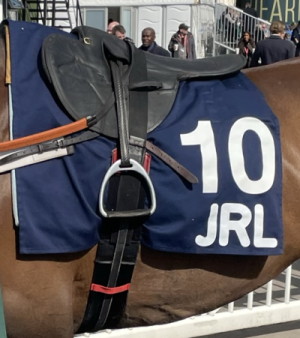Who Handicaps The Grand National Racehorses And How Is It Decided?
 The Grand National is the biggest horse race in the UK, with a field of 40 runners aiming to win the prize each season. When you think about what it takes to win the Grand National, you think of things such as luck in running when those around are falling, jumping ability, effectiveness on the ground and the positioning of a horse.
The Grand National is the biggest horse race in the UK, with a field of 40 runners aiming to win the prize each season. When you think about what it takes to win the Grand National, you think of things such as luck in running when those around are falling, jumping ability, effectiveness on the ground and the positioning of a horse.
However, the biggest factor is actually something that is decided a couple of months before the race, and that is the handicap. This determines what weight each horse will carry, and the moment these are released, they are fixed in place, regardless of what happens between that moment and race day.
The Grand National Handicapper
The Grand National handicapper is always whoever is in charge of handicapping chase races for the BHA. At the moment, that is Martin Greenwood, handicapping the most recent Grand National in 2023, the fifth race he has been in charge of.
His job is to put together all runners, the form on offer, combine the UK and Irish contingents and work out what weight each horse should carry in the race. This is done at the February entry stage, so more often than not, the weights are made for numbers well in advance of the 40 that actually compete when we reach April.
What is the Job of a Handicapper?
 Essentially, like any other handicap horse race that takes place, the Grand National handicapper has the job of making the race as fair and even as possible. If a handicapper gets his job right, every single horse should cross the finish line at precisely the same time, creating a dead-heat photo finish amongst all the runners.
Essentially, like any other handicap horse race that takes place, the Grand National handicapper has the job of making the race as fair and even as possible. If a handicapper gets his job right, every single horse should cross the finish line at precisely the same time, creating a dead-heat photo finish amongst all the runners.
Of course, there has never been a race like that, as other variables, such as the conditions, luck in running, jockey ability and more, also have a say on the outcome of a race. Having said that, the closer a race is, the better the job done by the handicapper.
Handicapping begins with the top weights in the race, the best horses with the highest ratings. They are allotted a weight, and things work down from there. For every number in the ratings that are given, 1lb in weight is the difference. So, a horse rated 155 would carry 5 lbs less than a horse ranked 160.
The highest weight a horse can carry is 11st 10lb, while the lowest is 10st. If a horse’s rating means they should carry less than 10st, then they are known as being out of the handicap but have to carry the 10st minimum. These are horses classed as being badly handicapped because they are carrying more weight than the handicapper believes they should have.
The Difficulties of Handicapping the Grand National
 Of course, handicapping the Grand National is not easy and brings many difficulties for the man in charge. There is a lot to consider, including form, past runs over the fences, improvement coming, and a lot more. This all combines to make the job one of the toughest in racing.
Of course, handicapping the Grand National is not easy and brings many difficulties for the man in charge. There is a lot to consider, including form, past runs over the fences, improvement coming, and a lot more. This all combines to make the job one of the toughest in racing.
Many runners who aim for the Grand National are trained with the race in mind for the entire season, despite it coming at the very end. This means that some will even avoid running over fences instead of running over hurdles to try and protect their handicap mark for the big race.
We also see a lot of horses running over shorter distances, not showing their full hand ahead of the big one and running on well in the closing stages. This all makes the puzzle even tougher to work out, as not only are handicappers looking at bare facts but also trying to second guess what horses have done and what they may be able to do in the future.
Lastly, handicapping the Grand National is something that takes place two months before the event itself. This means that when the weights are set in stone, nothing can be done afterwards, regardless of what horses do between then and the race. This can make the handicapper look like they’ve got things wrong, as horses impress afterwards, though, of course, the cynical people out there would say that trainers have been specifically waiting to run after they know their weight.
The 2023 Grand National winner Corach Rambler was a prime example of this. He was allotted a rating of 146 in February ahead of his bid for the Grand National. In March, after receiving his weight, he ran at the Cheltenham Festival and won the Ultima Handicap Chase, a strongly contested 3m1f chase race, in many ways, an ideal preparation for the big one.
He won that race by a neck and was given a rise in the handicap of 10lb for that win. However, the horse had already received his Grand National rating, which could not change, so he was still able to run off 146 in the race, even though he was officially rated 156 at the time of the race.
Going into the race, the horse was 10lb well in when comparing his Grand National rating to his official rating at the time of the race, and given that he won the race, you would have to agree that was the case.
Criticism of Grand National Handicapping
 Of course, with a job as important as handicapping, something that is predominately based on opinions of horses, criticism is undoubtedly something that will be given from time to time. All trainers, owners and jockeys want their horses to have a great chance of winning, and if the handicapper gives them a weight they don’t believe gives them a chance of winning, they are likely to make their feelings known.
Of course, with a job as important as handicapping, something that is predominately based on opinions of horses, criticism is undoubtedly something that will be given from time to time. All trainers, owners and jockeys want their horses to have a great chance of winning, and if the handicapper gives them a weight they don’t believe gives them a chance of winning, they are likely to make their feelings known.
The biggest instance of this happening was with a horse that will be remembered as a Grand National legend, and that was Tiger Roll. He won the Grand National in 2018 and 2019 and became a legend of the race, but we were robbed of seeing him win the race for a third time when he was twice withdrawn from the contest after the weights were revealed.
After no race in 2020, fans had hoped to see him try and emulate Red Rum by winning his third Grand National in 2021. However, after being given a rating for the race of 166, owner Michael O’Leary decided that was an unfair weight and pulled him out.
This wasn’t a situation where the handicapper could really win because after seeing the horse win the last two running’s of the race, he had to give the horse a big weight in order to give everyone else a chance.
A year later, in 2022, the same happened again, with owner Michael O’Leary taking a swipe at Martin Greenwood once again, criticising the weight he gave the horse. This time around, the rating given was 161, meaning the horse would have to carry at least 11st 4lb, but more if some of those higher in the weights were to pull out.
 The rating given to the 2019 winner was the same as the one given to the 2021 winner Minella Times, which was the main reason for O’Leary’s disagreement. He stated that the horse would be running as a 12-year-old, was on the decline, and was not given a fair chance of winning the race due to the weight on his back.
The rating given to the 2019 winner was the same as the one given to the 2021 winner Minella Times, which was the main reason for O’Leary’s disagreement. He stated that the horse would be running as a 12-year-old, was on the decline, and was not given a fair chance of winning the race due to the weight on his back.
O’Leary took the horse out again, making a point to mention that he didn’t think it was fair or safe to send his 12-year-old runner around Aintree with so much weight on his back.
What made the story bigger was the public appetite to see Tiger Roll in the Grand National for one last time. We missed it in 2021 and then again in 2022, and regardless of who was at fault, whether it was the handicapper or the owner, we didn’t get to see the horse on the track, which is what we all wanted.
The handicapper does not have an easy job and will often get things wrong. That’s part of the race because there are 40 runners, plus others who are entered but don’t get a run, getting it all right is an almost impossible task.
But aside from that, it is a job that must be done, and perhaps the biggest job for the race, alongside being the official starter on the day.
